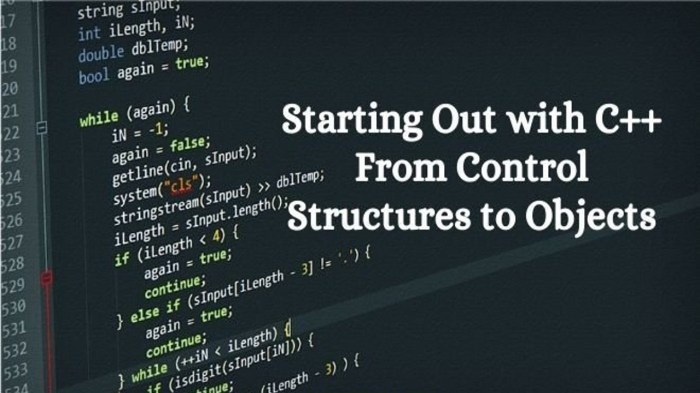Starting out with c++ from control structures to objects pdf – Starting Out with C++: From Control Structures to Objects PDF is an invaluable resource for anyone looking to master the fundamentals of C++ programming. This comprehensive guide provides a clear and concise introduction to the basics of C++ syntax and structure, as well as more advanced concepts such as control structures, functions, arrays, pointers, classes, objects, and object-oriented programming.
Whether you’re a complete beginner or an experienced programmer looking to brush up on your skills, Starting Out with C++ has everything you need to get started with this powerful and versatile programming language.
1. Introduction to C++
C++ is a powerful and versatile programming language that is widely used in software development. It is an object-oriented language, which means that it is designed to make it easy to create and manage complex data structures and programs.
C++ is a compiled language, which means that it is converted into machine code before it is run. This makes it faster than interpreted languages, such as Python or JavaScript.
Data Types and Operators
- C++ has a wide variety of data types, including integers, floating-point numbers, characters, and strings.
- C++ also has a rich set of operators, which can be used to perform a variety of operations on data.
2. Control Structures
Control structures are used to control the flow of a program. They allow you to specify which parts of the program should be executed and in what order.
if-else Statement
The if-else statement is used to execute different code depending on whether a condition is true or false.
switch Statement
The switch statement is used to execute different code depending on the value of a variable.
Loops
Loops are used to execute a block of code multiple times.
3. Functions

Functions are used to break a program down into smaller, more manageable pieces.
Declaring Functions
To declare a function, you need to specify the return type, the function name, and the parameter list.
Defining Functions
To define a function, you need to provide the implementation of the function.
Calling Functions
To call a function, you need to specify the function name and the arguments to pass to the function.
4. Arrays and Pointers: Starting Out With C++ From Control Structures To Objects Pdf
Arrays are used to store a collection of data items of the same type.
Pointers are used to store the address of a variable.
Declaring Arrays
To declare an array, you need to specify the type of the array and the size of the array.
Initializing Arrays
To initialize an array, you can use an initializer list.
Accessing Arrays
To access an element of an array, you can use the array index.
Pointers
To declare a pointer, you need to specify the type of the pointer and the name of the pointer.
Dereferencing Pointers, Starting out with c++ from control structures to objects pdf
To dereference a pointer, you can use the asterisk operator (*).
5. Classes and Objects
Classes are used to create new data types.
Objects are instances of classes.
Declaring Classes
To declare a class, you need to use the class .
Defining Classes
To define a class, you need to provide the implementation of the class.
Creating Objects
To create an object, you need to use the new operator.
Accessing Class Members
To access the members of a class, you can use the dot operator (.).
6. Object-Oriented Programming
Object-oriented programming (OOP) is a programming paradigm that emphasizes the use of objects and classes.
Principles of OOP
- Encapsulation
- Inheritance
- Polymorphism
Benefits of OOP
- Increased code reusability
- Improved code maintainability
- Enhanced code extensibility
Question Bank
What is C++?
C++ is a general-purpose programming language that is widely used for developing a wide range of applications, including operating systems, embedded systems, and desktop applications.
What are control structures?
Control structures are used to control the flow of a program. They allow you to execute different blocks of code depending on certain conditions.
What are objects?
Objects are instances of classes. They contain data and methods that operate on that data.